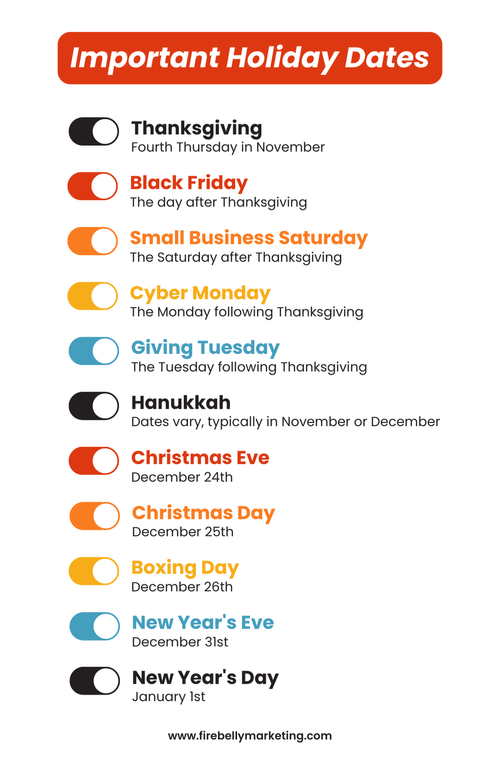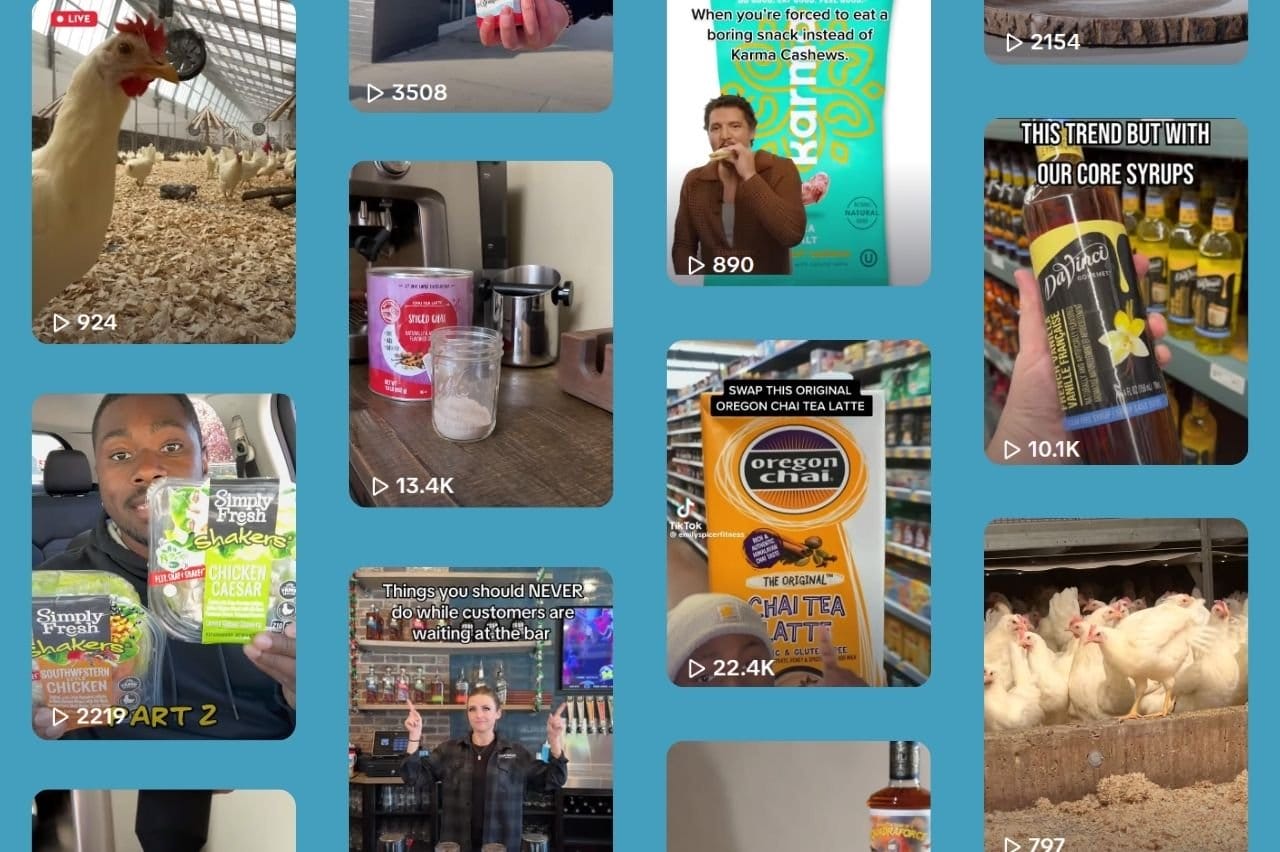Holiday Marketing Campaigns: Strategies for Success in the Festive Season

A guide to making sales in March look like mid-December
The holiday season is a crucial time for businesses across all industries – especially CPG food & beverage brands. With consumers ready to spend and competition at its peak, having a well-planned holiday marketing campaign can make all the difference.
We build dynamic social media marketing strategies for food & beverage brands. We’ve decided to explore the ins and outs of holiday marketing campaigns, why they’re essential, and how to create strategies to help your brand stand out. Because this time of year is as competitive as it is cozy.
Effective holiday marketing campaigns incorporate multiple channels, including:
- Social media platforms
- Email marketing
- Content marketing (blogs, videos, infographics)
- Paid advertising (PPC, social media ads)
- Influencer partnerships
- In-store promotions (for brick-and-mortar businesses)
By leveraging these various channels, businesses can create a cohesive and impactful holiday marketing strategy that reaches customers at different touch points throughout their buying journey. It’s all about omnichannel… But remember that social media continues to evolve as a vital marketing channel – 67% of consumers say it’s how they choose which brands to try.
Important Holiday Dates
When planning your holiday marketing campaigns, it’s crucial to be aware of key dates that can drive sales and engagement. Here are some of the most important dates to consider:

- Thanksgiving (Fourth Thursday in November): While not traditionally a shopping holiday, Thanksgiving offers opportunities for gratitude-themed marketing and early Black Friday promotions.
- Black Friday (The day after Thanksgiving): Known for its doorbuster deals and massive discounts, Black Friday marks the unofficial start of the holiday shopping season.
- Small Business Saturday (The Saturday after Thanksgiving): This day encourages consumers to support local and small businesses.
- Cyber Monday (The Monday following Thanksgiving): Created to encourage online shopping, Cyber Monday has become one of the biggest e-commerce days of the year.
- Giving Tuesday (The Tuesday following Thanksgiving): A day dedicated to charitable giving and supporting non-profit organizations.
- Hanukkah (Dates vary, typically in November or December): An eight-day Jewish festival that presents opportunities for themed promotions and gift ideas.
- Christmas Eve (December 24th) and Christmas Day (December 25th): The culmination of the holiday shopping season, with last-minute shoppers and gift-giving traditions. Note: 20-30% of year-round sales across all industries are attributed to purchases related to Christmas.
- Boxing Day (December 26th): Popular in some countries for post-Christmas sales and promotions.
- New Year’s Eve (December 31st) and New Year’s Day (January 1st): Opportunities for end-of-year sales and resolution-themed marketing campaigns.
Each of these dates presents unique opportunities for marketing campaigns tailored to the specific holiday or shopping event (note that you also shouldn’t forget about Halloween). By planning campaigns around these key dates, businesses can tap into the heightened consumer interest and spending occurring during these periods.
Why It’s Important to Have a Plan
Having a well-thought-out plan for your holiday marketing campaigns is crucial for several reasons:
- Competition: The holiday season is the busiest time of year for most retailers and service providers. Without a solid plan, your brand risks getting lost in the noise of competitors’ marketing efforts. A strategic plan helps you differentiate your offerings and cut through the clutter.
- Urgency: Holiday shoppers often operate with a sense of urgency (this kicks in in the lead-up to Black Friday), looking for the best deals and gifts within a limited timeframe. A planned campaign allows you to capitalize on this urgency effectively by creating time-sensitive offers and promotions that motivate quick decisions.
- Demand: Consumer demand peaks during the holiday season. A strategic plan helps you meet this demand with targeted offers and promotions, ensuring you have the right products or services available at the right time.
- Resource Allocation: Proper planning allows for efficient allocation of resources, ensuring that your marketing budget and efforts are used effectively across various channels and initiatives. This includes staffing, inventory management, and marketing spend.
- Consistency: A well-planned campaign ensures consistency in messaging and branding across all marketing touchpoints, reinforcing your brand identity during this critical period. This consistency helps build trust and recognition with your audience. It’s also essential to make sure your brand voice is baked into every aspect of your messaging.
- Maximizing Opportunities: With a plan in place, you’re better positioned to take advantage of unexpected opportunities that may arise during the holiday season, such as trending topics or viral marketing moments. These are especially important on TikTok, which 58% of users rely on for product recommendations.
- Customer Experience: Planning ahead allows you to create a seamless and enjoyable customer experience throughout the holiday season, from browsing to purchasing to post-sale support.
- Data Utilization: A well-structured plan enables you to effectively use data from previous holiday seasons to inform your strategies, helping you make data-driven decisions for better results.
“58% of users rely on Tiktok for product recommendations. ”
By investing time and effort into planning your holiday marketing campaigns, you set your business up for success during this critical sales period.
When You Should Start
The key to a successful holiday marketing campaign is starting early. Here’s a suggested timeline to help you plan effectively:
- July-August:
- Begin brainstorming campaign ideas and themes.
- Analyze data from previous holiday seasons to inform your strategy.
- Start planning your inventory and supply chain logistics.
- September:
- Finalize your campaign strategy and start creating content.
- Develop your creative assets, including ad designs, email templates, and social media content.
- Plan your promotional calendar, including key dates for sales and special offers.
- October:
- Launch teaser campaigns to build anticipation.
- Begin ramping up your marketing efforts across all channels.
- Ensure your website is optimized for holiday traffic and mobile shoppers.
- November-December:
- Execute your full-scale holiday marketing campaigns.
- Monitor performance closely and be prepared to make real-time adjustments.
- Increase customer support to handle higher volumes of inquiries.
- January:
- Analyze campaign performance and gather insights.
- Send post-holiday follow-up communications to customers.
- Start planning for the next holiday season, incorporating lessons learned.
Remember, many consumers start their holiday shopping as early as October (during the spooky season – a lucrative time for CPG brands), so having your campaigns ready to go by then can give you a significant advantage. Early planning also allows you to secure prime advertising spots and influencer partnerships before they become scarce or more expensive.
Top 7 Holiday Campaign Ideas
- Festive Giveaways Giveaways are an excellent way to generate excitement and engage with your audience during the holiday season. Consider running a “12 Days of Christmas” giveaway, where you offer a new prize each day leading up to Christmas. This not only creates buzz around your brand but also encourages repeat visits to your website or social media pages.Example: A beauty brand could offer a different skincare or makeup product each day, culminating in a grand prize of a full holiday collection on the final day.
- Holiday Sales and PromotionsCreate irresistible holiday offers to attract shoppers. This could include percentage discounts, buy-one-get-one deals, or free shipping on orders over a certain amount. Be sure to highlight the exclusivity and time-sensitive nature of these offers to drive urgency.Strategies to consider:
- Flash sales for limited periods
- Tiered discounts (e.g., 10% off $50, 15% off $100, 20% off $150)
- Bundle deals that encourage larger purchases
- Free gift with purchase promotions
- Free Shipping on purchases over $50
- Countdown to the HolidaysBuild anticipation with a holiday countdown campaign. This could be an advent calendar-style promotion where you reveal a new deal, product, or piece of content each day. This keeps your audience engaged and coming back for more throughout the season.Ideas for countdown content:
- Daily product reveals for a new holiday collection
- Tips and tricks related to your industry (e.g., holiday recipes for a food brand)
- Behind-the-scenes glimpses of your holiday preparations
- User-generated content features
- Curated Gift GuidesCreate themed gift guides to help your customers find the perfect presents for their loved ones. Segment your guides by recipient (e.g., “Gifts for Mom,” “Gifts for Tech Lovers”) or by price point. This not only provides value to your customers but also showcases your products organically.Tips for effective gift guides:
- Include a range of price points to cater to different budgets
- Incorporate product photos and brief descriptions
- Make the guides easily shareable on social media
- Consider creating video versions for platforms like YouTube or TikTok
- Strategic CollaborationsPartner with complementary brands or influencers to expand your reach during the holiday season. This could involve co-created products, joint promotions, or influencer-curated gift guides featuring your products. Collaborations can help you tap into new audiences and add credibility to your brand.Collaboration ideas:
- Limited edition product collaborations with artists or designers
- Cross-promotions with complementary brands (e.g., a coffee brand partnering with a milk frother)
- Influencer takeovers of your social media accounts for a day
- Charity partnerships that align with your brand values
- Trending Content CreationLeverage popular holiday trends and hashtags in your social media content. Create entertaining and shareable content that aligns with these trends while showcasing your products or services. This could include holiday-themed TikTok challenges, Instagram Reels, or Pinterest boards.Content ideas:
- Holiday decoration tutorials featuring your products
- “Unboxing” videos of your holiday gift sets
- Festive recipes or DIY projects related to your brand
- Holiday-themed user-generated content contests
- Email Marketing CampaignsDevelop a series of targeted email campaigns to nurture your subscribers throughout the holiday season. This could include early access to sales for loyal customers, personalized product recommendations based on past purchases, or abandoned cart reminders with special holiday incentives to complete the purchase.Email campaign strategies:
- Segment your email list based on customer behavior and preferences
- Use dynamic content to personalize emails for each recipient
- Create a sense of urgency with countdown timers for limited-time offers
- Include clear and prominent calls-to-action (CTAs) in every email
- Optimize your emails for mobile devices
Post-Holiday Follow-Up
It’s crucial to take a step back and thoroughly analyze the performance of your campaigns once January hits. This post-holiday assessment not only helps you understand the success of your recent efforts but also informs your strategies for future holiday seasons and year-round marketing initiatives.
Begin by diving deep into your sales data:
- Evaluate your holiday sales figures against your initial projections and past years’ performance.
- This comparison will give you a clear picture of your growth and the effectiveness of your campaigns.
- Dig deeper into the overall numbers to pinpoint which products or services were the season’s top performers.
- Understanding these top performers can guide your inventory decisions and marketing focus for the next holiday rush.
Next, turn your attention to website traffic:
- Examine the increases in visits to your site and pinpoint which campaigns were the most effective in driving this traffic.
- Pay close attention to user behavior on your site, including the most popular pages and the paths that led to conversions.
- In today’s mobile-first world, it’s also essential to assess the balance between mobile and desktop traffic to ensure your site is optimized for all devices.
Engagement rates across your various marketing channels provide valuable insights into whether your content is making an impact on consumers:
- Measure metrics such as likes, comments, shares, and click-through rates on your holiday content.
- This analysis will help you identify which types of content resonated with your audience and on which platforms they were most active.
- Use these insights to refine your content strategy for future campaigns.
Email marketing often plays a crucial role in holiday campaigns, so give it special attention:
- Examine open rates, click-through rates, and conversion rates for your holiday email campaigns.
- Identify which subject lines caught your audience’s attention and what content types spurred them to action.
- Also, consider how the frequency of your emails impacted engagement and unsubscribe rates – finding the right balance is key to maintaining a healthy email list.
Other things to consider:
- While numbers tell part of the story, don’t forget the invaluable insights from your customers. Review comments and feedback across all channels to gauge satisfaction with your holiday offerings. Consider conducting post-holiday surveys to gather more detailed insights. Additionally, analyze customer service interactions to identify common issues or praise, which can inform your product development and customer service strategies.
- Calculating the return on investment (ROI) for each campaign is crucial in determining which strategies were most cost-effective. However, remember to consider monetary returns and non-monetary benefits like increased brand awareness and customer loyalty. These softer metrics can have significant long-term value for your business.
- An often-overlooked aspect of post-holiday analysis is inventory assessment. Evaluate the accuracy of your inventory forecasts and identify any instances of stockouts or overstock situations. This information is vital for improving your planning and logistics for future high-demand periods.
- While focusing on your own performance is important, don’t forget a competitive analysis. Review their holiday strategies and performance to identify areas where you can differentiate or improve for the next holiday season. This can spark new ideas and help you stay ahead of industry trends.
- Gather your team for a comprehensive post-holiday debrief. This meeting is an opportunity to discuss successes, challenges, and lessons learned. Be sure to include insights from staff who interacted directly with customers during the holiday rush, as they often have valuable frontline perspectives that might not be captured in data alone.
- Finally, use these insights to outline strategies for the next holiday season. Identify areas for improvement and new opportunities to explore. Remember that the post-holiday period is also an excellent time to re-engage customers with new year promotions, loyalty programs, or even early bird offers for the next holiday season.
By conducting a thorough post-holiday analysis, you set yourself up for continued success. This reflective process allows you to refine your approach continuously, ensuring that each holiday season is more successful than the last. Moreover, many of the insights gained from your holiday campaigns can inform and improve your marketing strategies throughout the year.
The most wonderful time of the year
Holiday marketing campaigns are a vital component of any successful business strategy. By planning, leveraging creative campaign ideas, and analyzing your results, you can capitalize on the increased consumer activity during this festive time of year. Remember to stay true to your brand while embracing the holiday spirit, and you’ll be well on your way to a successful holiday season.
Key takeaways for successful holiday marketing campaigns:
- Start planning early to stay ahead of the competition.
- Create a multi-channel approach to reach customers across various touchpoints.
- Use data from previous years to inform your strategies.
- Be creative and authentic in your campaign ideas to stand out.
- Prioritize customer experience throughout the holiday shopping journey.
- Stay flexible and be prepared to adapt your strategies as needed.
- Conduct thorough post-holiday analysis to continuously improve your approach.
By implementing these strategies and staying committed to delivering value to your customers, you can create memorable holiday marketing campaigns that drive results and build lasting relationships with your audience.


